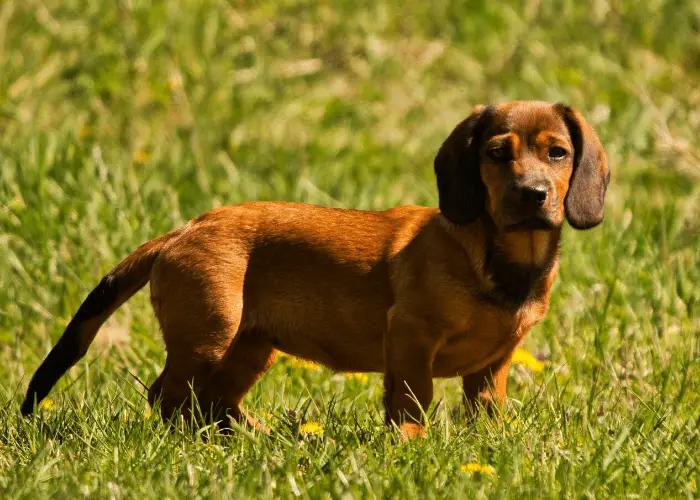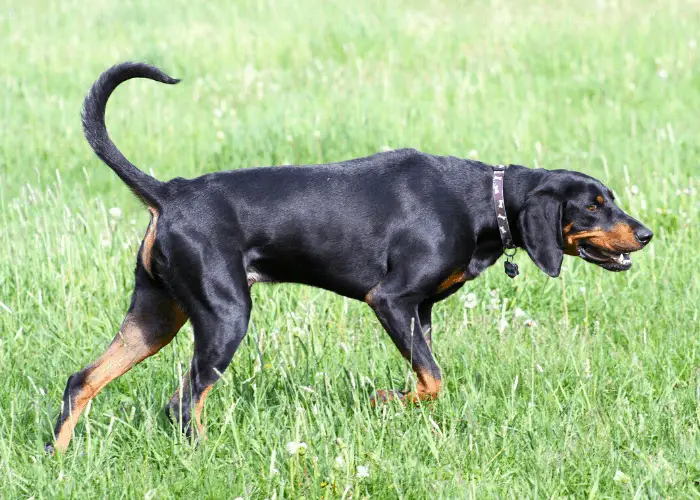The following is an article that will talk about 5 Austrian dog breeds that have been used for decades to assist in guarding, hunting, and tracking.
Austria has produced its share of breeds over the years, and since the 1800s, they’ve bred some successful hunting dogs.
Deeper research should go into any of these breeds to determine whether or not they’d be the right dog for you.
1. Alpine Dachsbracke

Highlights: Small, Friendly, Fearless
The Alpine Dachsbracke can be dated back to around the mid-19th century.
Generally, this is a smaller breed of dog, a scent type hound that was bred for hunting and tracking.
Dachsbrackes were bred to track wounded animals in flight such as deer, boar, and to assist in tracking smaller game as well.
These are small-legged yet have a longer bodied build similar to a Dachshund, and their fur is typically short and full, being slightly longer down the back and throughout the tail.
They are Solid red (Deer Red), with some black hair peppered through on occasion, or black with reddish-brown markings throughout.
The breed’s temperament is generally fearless, friendly, and intelligent. Still, it is often used as a hunter’s companion due to its many strengths in that particular activity.
Dachsbrackes are great around children and are often well behaved around other dogs.
Did You Know?
- Habsburg’s Prince Rudolf brought his Dachsbracke on trips with him. Records show that his dog accompanied him on hunting trips in Egypt and Turkey in the 1880s.
- They enjoy an incredibly good sense of smell.
- Their lower center of gravity makes these dogs effective in mountainous terrain.
2. Austrian Black and Tan Hound

Highlights: Medium to Large, Well Behaved, Good Country Dog
The Austrian Black and Tan Hound is another hunting breed that was mostly used in the higher elevations, and most popular for tracking hare or other wounded animals in flight.
Its sharp sense of smell along with its long legs make this make it easy to track and chase down game.
The breed originated in Austria, but there is no record of how it came into existence. Presumably, they are a direct descendant of the ancient Celtic Hound. It popped into the scene historically in the mid-19th century.
This is a large breed of K9 with a smooth, thick, and short coat of fur, and a unique, slightly bent long tail. Its color is mostly black with some tan running up the feet, and fawn markings above the eyes.
They have a friendly and playful temperament that makes for a great family pet and is generally well behaved around other dogs. However, this isn’t a breed that would be well suited for city living, as they need room to spread their legs and run around.
Did You Know?
- There is a theory that they descended from dogs developed by the Monks of St. Hubert’s Monastery over 1,000 years ago.
- Austrian Black and Tan Hounds are revered for their trainability.
- They are not very well known around the world and are found mainly in Austria.
3. Austrian Pinscher

Highlights: Medium Size, Originally a Farm Dog, Playful
The Austrian Pinscher was originally a working farm dog. It specialized in pest control, home security, and guarding livestock. It became recognized as a breed in 1928 by the Austrian Kennel Club.
Its fur is short, and thick having a double coat. Breed coloring can vary from dog to dog. Yellow, red, black, and tan colors are normal, mixed with white on the feet, head, tail, and chest. They’re medium in size with a thick neck and curled tail.
The Austrian Pinscher is renowned for being a pleasant companion and is comfortable in either rural or urban environments. They are friendly, playful, affectionate, but are an uncompromising guard.
Did You Know?
- The numbers for this breed dwindled so drastically that by the mid-1970s, only one from the original breeding pack was left.
- Despite vigorous attempts to expand the breed, there is only a small population of Austrian Pinschers alive today, mostly remaining in Austria.
- Socialization will curb the breed’s natural guardian instinct.
4. Styrian Coarse-Haired Hound

Highlights: Medium-Sized, Muscular Body, Dedicated Hunting Dog
The Styrian Coarse-Haired Hound hails from where the name denotes- the Austrian Province of Styria. The breed was selectively created in 1870 as a robust hunting dog.
The breed is medium-sized, muscular, and always has an “all business” expression on its face. The fur of the dog is coarse yet not long and shaggy and is unkept in appearance.
The color of the coat can be either red or fawn, and white dots on the chest are not uncommon.
Though useful as a working or hunting dog, many of its instincts make this breed not to be suitable for most families as a pet.
The same strong traits that make this a successful hunting dog, also make it stubborn, aggressive toward achieving what it wants to achieve.
Perhaps a mature family with plenty of dog training experience would be fine, but they don’t take to children as well.
Did You Know?
- This dog deals well with extreme temperature differences.
- Hunters in Austria still use the Styrian Course-Haired Hound to assist in hunting wild boar.
- They have a reputation of never quitting when it comes to finding their target- even in the face of exhaustion or hunger.
5. Tyrolean Hound

Highlights: Medium to Large, Working, Affectionate
The Tyrolean Hound (otherwise called the Tyroler Bracke) was in development as a breed from 1860 to 1896. It was later recognized as a breed in 1908 by the Austrian Kennel Club, but failed to be recognized by the United Kennel Club until 2006.
Similar to the Austrian Black and Tan Hound, the Tyrolean Hound is a descendant of the ancient Celtic Hound. It is scent hound with refined hunting skills. They’re good in all weather and terrain and can track over long distances.
This breed can often be a tri-colored dog with a combination of red, tan, and black, or have black and tan fur, with a short double-coat.
When the Tyrolean Hound is on task, little can come between itself and its objective. Otherwise, this is a warm and loving breed that fits well with most family situations providing that there’s ample exercise.
Did You Know?
- This breed was first meant to adapt to hunting in the snow.
- Emperor Maximilian I used this breed to track small or injured game.
- The Tyrolean Hound is a combination of Bracke hounds and the Celtic hounds.
Conclusion
If anything, these five breeds show us that it doesn’t take size to be an effective working dog. All of them need extra attention when it comes to exercise and training, and some are a better fit as a family dog than others.
But all of them are good at what they were bred to do and will serve you well if you allow them to play to their instinct-fed strengths. Hunting, tracking, solving puzzles, and plenty of room to run and play.
You can browse more European Dog Breeds in the links below:

